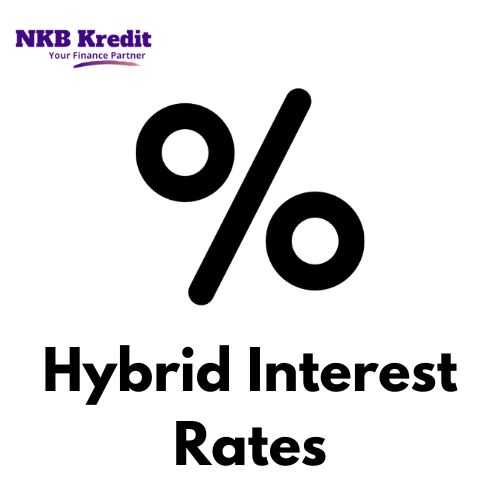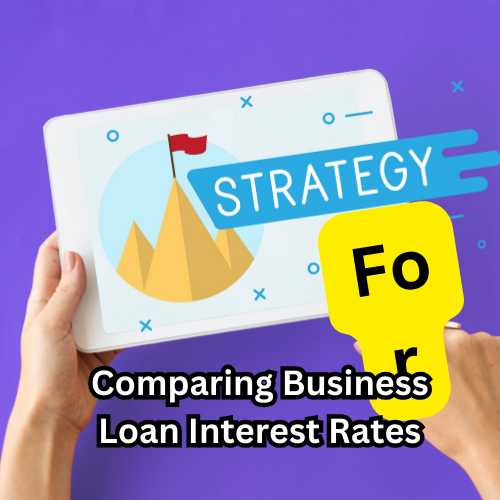Table of Contents
Introduction:- Compare Business Loan Interest Rates

Compare Business Loan Interest Rates:- Interest rates play a crucial role in business loans, impacting both borrowers and the overall cost of borrowing. In this comprehensive guide, we will explore the factors that affect business loan interest rates, the different types of interest rates available, how to understand interest rate structures and terms, and strategies for effectively comparing business loan interest rates.
Factors Affecting Business Interest Rates
Creditworthiness and Risk Assessment
When determining business loan interest rates, lenders assess the creditworthiness and risk profile of borrowers. This assessment takes into account some important factors, including::
- Credit Score History: Lenders consider the borrower’s credit score, which reflects their past financial behavior. A higher credit score may lead to lower interest rates, as it indicates a lower risk of default.
- Financial Statements and Cash Evaluation: Lenders analyze the financial statements and cash flow of the business to assess its ability to repay the loan. A strong financial position can result in more favorable interest rates.
- Collateral Offered for the Loan: Providing collateral can lower the perceived risk for lenders, potentially leading to lower interest rates. In the event of default, collateral acts as security for the lender..
Loan Term and Type
Different loan terms and types also impact interest rates:
- Term Loans: Term loans have a defined repayment schedule and are typically repaid over a fixed period. The interest rates on term loans are usually lower compared to other types of loans.
- Long-Term Loans: Long-term loans have an extended repayment period, often exceeding five years. These loans often have higher interest rates compared to shorter-term loans, reflecting the increased risk for the lender.
- Secured Loans vs. Unsecured Loans: Whereas unsecured loans don’t need collateral, secured loans must. Because there is less risk for lenders, secured loans typically offer lower interest rates.
Market Conditions and Economic Factors
Market conditions and the overall economic climate also influence business loan interest rates:
- Overall Economic Health: During periods of economic growth, interest rates may be lower due to increased demand for loans. Conversely, during economic downturns, interest rates tend to rise as lenders become more cautious.
- Inflation and Interest Rate Trends: High inflation can lead to higher interest rates, as lenders may seek to counter the eroding value of money. Monitoring inflation trends can provide insights into potential interest rate movements.
- Federal Reserve Policies: The monetary policy decisions of the Federal Reserve can impact interest rates. Changes in interest rates set by the Federal Reserve can ripple through various lending markets, affecting business loan interest rates.
Types of Business Loan Interest Rates
Business loan interest rates can be broadly categorized into three main types:
Fixed Interest Rates
Fixed interest rates don’t change during the course of the loan.. They offer stability and predictability for borrowers. Here are some key considerations:
- Advantages and Disadvantages: Fixed interest rates provide stability and allow for precise budgeting. However, they may be initially higher compared to variable rates. Borrowers are protected from market fluctuations during the loan term.
- Predictability and Budgeting: With fixed interest rates, borrowers can accurately predict their monthly payments, aiding in financial planning and budgeting.
- Long-Term Cost Comparison: It is essential to consider the long-term cost of fixed interest rates compared to other types. While initial rates may be higher, they may result in overall savings if interest rates rise in the future.
Variable Interest Rates
Variable interest rates can fluctuate over time, often tied to an external benchmark. Here’s what you need to know about variable interest rates:
- Advantages and Disadvantages: Variable interest rates can provide lower initial rates and potential savings if market rates decrease. However, they introduce uncertainty and can result in higher payments if rates rise.
- Market Fluctuations and Economic Impact: Variable rates are influenced by market conditions and economic factors. Borrowers need to stay informed about changes that could affect their interest rates.
- Risk Assessment and Uncertain Cost Comparison: Borrowers considering variable rates must assess their risk tolerance and evaluate the potential impact of rate fluctuations on their repayment capacity.
Hybrid Interest Rates

The components of both fixed and variable interest rates are combined in hybrid rates. Here are the main key features and benefits:
- Features and Benefits: Hybrid interest rates offer a combination of stability and flexibility. They typically start with a fixed rate for an initial period and transition to a variable rate afterward.
- Combination of Fixed and Variable Rates: Hybrid rates provide an opportunity to benefit from lower initial fixed rates while having the potential for savings if market rates decline.
- Suitability for Different Business Needs: The suitability of hybrid rates depends on individual business circumstances and risk preferences. They may be attractive for borrowers seeking a balanced approach.

Understanding Interest Rate Structures and Terms
To make informed decisions and effectively compare business loan interest rates, it’s crucial to understand key concepts related to interest rates:
Annual Percentage Rate (APR)
- Definition and Calculation: The APR represents the annualized cost of borrowing, including both the interest rate and other associated fees. It accounts for the total cost of the loan over time and allows for easy comparisons between loan offers.
- Incorporating Additional Loan Costs: The APR includes fees like origination fees, closing costs, and other charges associated with the loan. Knowing the APR helps borrowers understand the true cost of borrowing.
- Importance in Loan Comparisons: Comparing loan offers based on APR allows borrowers to identify the most cost-effective options. It enables a clearer understanding of the overall expense of borrowing.
Simple Interest vs. Compound Interest
- Explanation and Comparison: Simple interest is calculated solely based on the principal amount, while compound interest includes both the principal and accumulated interest. Over the time, compound interest can dramatically raise borrowing costs.
- Effects on Loan Repayment: Simple interest results in lower interest costs compared to compound interest. Understanding the interest calculation method helps borrowers plan their repayment strategy effectively.
- Considerations for Business Borrowers: Business borrowers should consider the impact of interest compounding on long-term loans. It’s important to evaluate the repayment structure and interest calculation method to make informed decisions.
Prime Rate and Spread
- Definition and Role in Lending: The prime rate is the benchmark interest rate that banks charge their most creditworthy customers. Lenders often add a spread, which is a percentage above the prime rate, to determine the interest rate charged to borrowers.
- Determining the Prime Rate: The prime rate is influenced by the Federal Reserve’s monetary policy and overall market conditions. It serves as a reference point for many loans, especially those with variable interest rates.
- Understanding the Spread and its Impact: The spread is determined by the lender and reflects the level of risk associated with the borrower. Higher-risk borrowers may have a higher spread, resulting in a higher interest rate.
Strategies for Comparing Business Loan Interest Rates

Effectively comparing business loan interest rates involves the following strategies:
Shopping Around for the Best Deals
- Researching Financial Institutions and Lenders: Look for reputable financial institutions and lenders that offer business loans. Think about their dependability, reputation, and client testimonials.
- Requesting Loan Quotes and Offers: Reach out to multiple lenders and request loan quotes. Compare the interest rates, terms, and other relevant information provided in the loan offers.
- Analyzing the Fine Print and Additional Fees: Carefully review the loan agreements and understand the terms and conditions. Pay attention to any additional fees, prepayment penalties, or hidden charges.
Utilizing Loan Comparison Tools
- Online Resources and Calculators: Take advantage of online resources that provide loan comparison tools and calculators. These tools can assist in evaluating different loan offers and their associated costs.
- Comparison Websites and Platforms: Utilize comparison websites and platforms specifically designed for comparing business loan interest rates. These platforms provide a centralized location for comparing multiple offers.
- Evaluating the Accuracy and Reliability: When using loan comparison tools, ensure they are reliable and up-to-date. Double-check any calculations or estimates provided and verify the accuracy of the data.
Seeking Professional Advice
- Consulting with Financial Advisors: Seek advice from financial advisors who specialize in business loans. They can provide professional insights and guide you through the loan comparison process.
- Discussing with Business Loan Specialists: Consult with business loan specialists who have expertise in different loan products and interest rate options. They can provide advice that are customized for your particular needs.
- Enlisting the Help of Accountants or CPAs: Accountants or Certified Public Accountants (CPAs) can provide valuable input regarding the financial impact of different interest rate options. Their expertise can help you make well-informed decisions.
Summary

Understanding and comparing business loan interest rates is crucial for borrowers looking to secure financing. By considering factors such as creditworthiness, loan term, and interest rate structures, and employing effective comparison strategies, borrowers can make informed decisions that align with their business needs and financial goals.
Frequently Asked Questions (FAQs)
Q: Are interest rates the only cost to consider when choosing a business loan?
A: No, borrowers should also consider additional fees, repayment terms, and loan conditions.
Q: Can a business’s creditworthiness impact the interest rate offered?
A: Yes, lenders use credit scores, financial statements, and cash flow evaluations to determine interest rates.
Q: Can the interest rate on a business loan change over time?
A: Yes, variable interest rates can fluctuate based on market conditions, while fixed rates remain constant.
Q: How can I compare business loan interest rates accurately?
A: By considering factors such as loan type, term, interest rate structures, and seeking multiple quotes.
Q: Is it better to choose a fixed or variable interest rate for a business loan?
A: It depends on business needs, risk tolerance, and market conditions. Each has its own advantages and considerations.





[…] Understanding and Compare Business Loan Interest Rates: A Comprehensive Guide […]